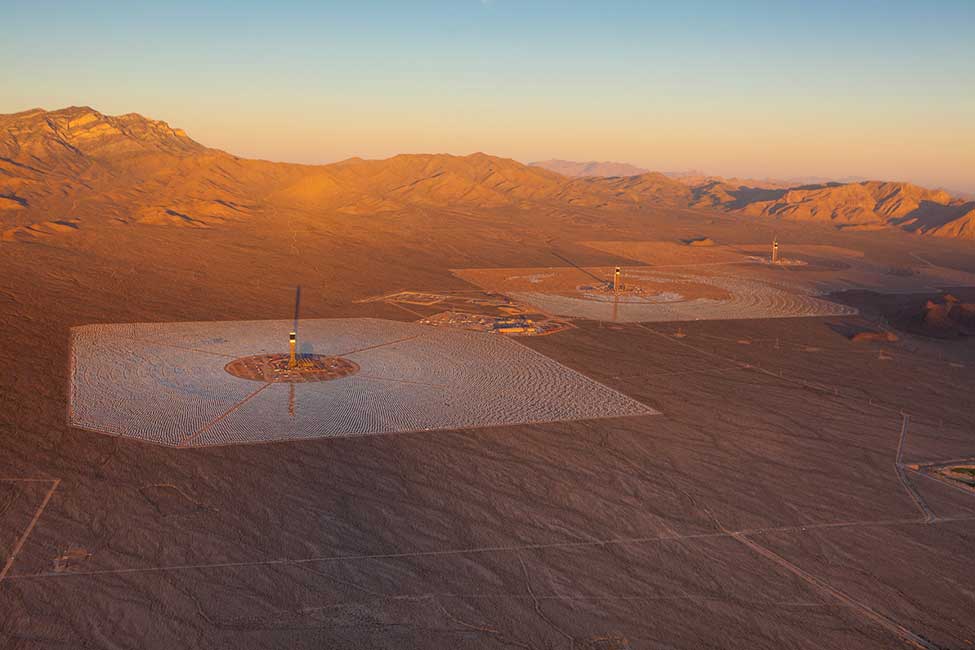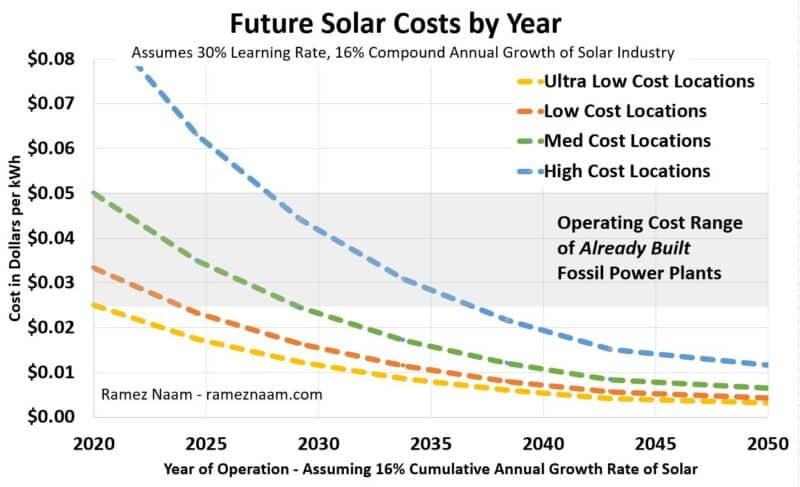The SHINING Future of Solar
Solar is the Most Abundant Source of Renewable Energy on the Planet
 Recently, there have been significant breakthroughs in solar energy that will advance the use of both photovoltaic (PV) and solar thermal technology.
Recently, there have been significant breakthroughs in solar energy that will advance the use of both photovoltaic (PV) and solar thermal technology.
Here is a guide on top solar companies as well as in-depth explanations of various solar projects. This guide offers different recommendations depending on what solar services are needed (comparing cost, customer satisfaction data, and technology).
Recent technological advancements are bringing solar PV down to a more affordable cost. Rooftop solar is getting substantially less expensive each year as PV also gets more efficient.
In the case of utility-scale PV (solar farms), solar energy is also available at an increasingly lower cost. Utility-scale solar is now cheaper when compared to fossil fuel energy (given an ideal location for the solar farm).
Breakthroughs in solar are not limited to PV, there are also breakthroughs in solar thermal technologies (CSP towers, solar parabolics, solar water heaters). Solar is the most abundant energy source available on the planet and is steadily dropping in cost while rising in efficiency.
 A key development that will enable the widespread, cost-efficient use of solar is the production of cells using less expensive, and readily available materials.
A key development that will enable the widespread, cost-efficient use of solar is the production of cells using less expensive, and readily available materials.
Silicon has traditionally been the preferred material for PV, however, cadmium telluride (CdTe), among other emerging PV cell materials, is now also used to produce PV cells as flexible thin-film cells or brittle crystalline structures. CdTe is used to produce highly efficient, low-cost solar cells.
Advanced solar PV technology, along with nano PV, is found in utility-scale thin-film solar farms, as well as most modern solar PV farms, rooftop PV, and solar arrays of every size.

Nano PV
Nano PV cells result in much more compact, thinner, and more efficient solar panels. Nanotechnologies in PV with from 4 to 7 times (or more) the efficiency of standard photovoltaic cells are in the R&D phase today, with limited commercial availability.
However, there are nano and alternative material PV cells with substantially higher efficiency than the traditional standard in the solar market (double to triple the efficiency of common solar cells that have typically had up to 19% efficiency).
The solar arrays now being produced could be exponentially improved with the development, refinement, and implementation of nanotechnology. For more information on materials used to make modern solar cells, please see Renewable Energy: Solar.
Solar Thermal
In addition to advancements in traditional photovoltaic technology, there have been exponential advancements in the field of solar thermal energy. Instead of simply converting energy from the sun into electricity as with PV, solar thermal technology uses energy from the sun to heat water, molten salt, or another working fluid. That heated liquid produces steam, which drives a generator to create electricity. Solar thermal represents an advancement in solar energy with 4 to 5 times the power density of PV.
CSP

Concentrated solar power (CSP) systems are examples of large-scale solar thermal projects. CSP solar tower generators consist of a central solar energy collector positioned on a tower (solar power tower) and used to concentrate solar energy to heat a working fluid.
The concentrated solar power is beamed to the solar power tower from thousands of mirrors (heliostats). Ivanpah Solar Electric Generating System is a good example of a successful large-scale CSP tower operation. Some of the most promising new projects in the world of solar power are in CSP.
Solar Parabolics
Another type of solar thermal energy system is a parabolic solar installation. Solar parabolic systems consist of solar dishes and troughs; and are used as grid-scale energy generators, as well as for large-scale energy storage. Additionally, other solar thermal technologies have found great use in the emerging field of thermal energy storage (see Science Direct link).
See this link for a detailed description of the various types of solar thermal systems touched on in this article, and more on solar thermal storage using molten salt; as well as more on solar water heating systems - sciencedirect.com/topics/engineering/solar-thermal-storage
Solar Water Heaters
Another commercially successful application of solar power is the solar-powered water heater. Solar-powered water heaters are mandatory in most new residential buildings and homes in the country of Israel, and now, in the state of Hawaii.
Some of the other new applications of solar thermal energy include power generation and solar space heating, as well as solar water heating; in industrial buildings, schools, hospitals, and even in remotely situated buildings.
Both types of solar energy (PV and solar thermal) will continue to steadily lessen in cost as technological advancements are made. However, photovoltaics are projected to remain ahead of thermal in terms of cost of production and utilization. Solar thermal does have a couple of advantages that compensate for the higher cost, though.
Solar thermal energy is produced consistently throughout the day, not relying on weather conditions. as the turbine will run on natural gas if there is no sun for an extended period of time. Solar thermal units fit easily with power storage systems and will continue to produce energy at night, using energy harnessed during the day.
Solar is Rising/ Dropping Costs of Solar
Below is a chart of RE's rise to mid-century as depicted in Bloomberg New Energy Finance's (BNEF) green scenario, especially solar and wind, and a few of BNEF's top-line takeaways from their energy outlook to 2050>>>

"1. WIND AND SOLAR MAKE UP ALMOST 50% OF WORLD ELECTRICITY IN 2050 – “50 BY 50” – AND HELP PUT THE POWER SECTOR ON TRACK FOR 2 DEGREES TO AT LEAST 2030.
2. A 12TW EXPANSION OF GENERATING CAPACITY REQUIRES ABOUT $13.3 TRILLION OF NEW INVESTMENT BETWEEN NOW AND 2050 – 77% OF WHICH GOES TO RENEWABLES.
3. EUROPE DECARBONIZES FURTHEST, FASTEST. COAL-HEAVY CHINA AND GAS-HEAVY U.S. PLAY CATCH-UP.
4. WIND AND SOLAR ARE NOW CHEAPEST ACROSS MORE THAN TWO-THIRDS OF THE WORLD. BY 2030 THEY UNDERCUT COMMISSIONED COAL AND GAS ALMOST EVERYWHERE."
FROM: BNEF.COM/NEW-ENERGY-OUTLOOK
The chart below illustrates the future trend of dropping costs for solar, to a level much lower than fossil fuel energy. Solar energy is already cheaper than all fossil fuel energy for utility-scale thin-film solar PV farms in many locations ideal for solar.

"In California (typical of the green line) we could be seeing unsubsidized solar at 2.5 cents per kwh. In northern Europe, we could be seeing utility-scale solar routinely priced at 4-5 US cents per kwh."
FROM - rameznaam.com/solars-future-is-insanely-cheap-2020
Related links on solar energy:
understandingnano.com/solarcells
grist.org/solar-power/harnessing-the-suns-energy-for-water-and-space-heating
Here's a quote from a BBC article titled "A breakthrough approach for solar power" about the rising efficiency of solar cells, and the growing use of solar worldwide>>>
"Today's average commercial solar panel converts 17-19% of the light energy hitting it to electricity. This is up from 12% just 10 years ago. But what if we could boost this to 30%? More efficient solar cells mean we could get much more than today's 2.4% of global electricity supply from the sun.
Solar is already the world's fastest growing energy technology. Ten years ago, there were only 20 gigawatts of installed solar capacity globally - one gigawatt being roughly the output of a single large power station. By the end of last year, the world's installed solar power had jumped to about 600 gigawatts."
FROM - bbc.com/May2020
